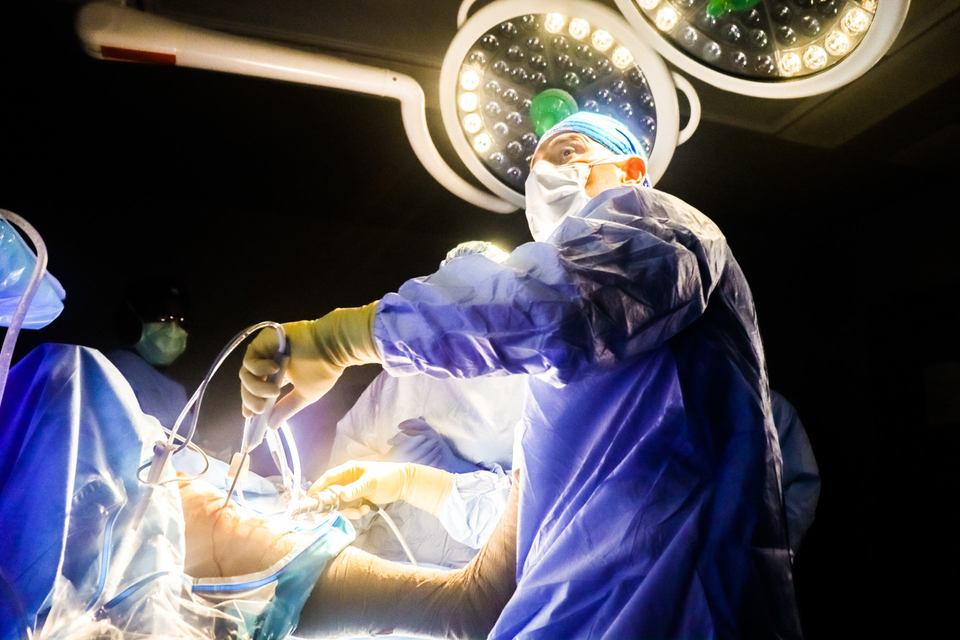EXTENDED HOURS FOR YOUR CONVENIENCE | OPEN WEEKLY UNTIL 7PM | SAME DAY APPOINTMENTS | MULTILINGUAL : ENGLISH, SPANISH, KOREAN, MANDARIN
Arthroscopy Surgery
Arthroscopy Surgery
Arthroscopic Surgery and Diagnosis in Atlanta
Up until relatively recently, receiving corrective surgery to treat injured or diseased joints required complicated, invasive surgeries.
Surgical results were much more inconsistent than they are today, and there were many instances where revisionary surgeries were necessary to fix the results or replace artificial joint components. Recovery times for invasive joint surgeries were long, scarring was often extensive and physical therapy and rehabilitation could be grueling.
Arthroscopy surgery was a truly game-changing development in the field of orthopaedic surgery. Procedures that used to require invasive surgeries – sometimes just for the purpose of visualizing and diagnosing a joint injury or condition – can now be performed with a pencil-sized instrument.
This instrument, known as an arthroscope, contains a miniaturized video camera and lighting system. During surgery the arthroscope is inserted through a small incision and gives the surgeon the ability to clearly see the joint and any injuries or conditions affecting it.
The invention of the arthroscope and other miniaturized surgical technology has led to a revolution in orthopaedic care and surgical solutions for all part of the musculoskeletal system, from hips and knees to shoulders and wrists.
Some of the surgical procedures that the Barbour Orthopaedics team can perform using arthroscopic technology include:
- Torn ligament repairs
- Arthroscopic rotator cuff surgery
- Torn cartilage (meniscus) repair in the knee or shoulder
- Loose bone or cartilage removal in the wrist, ankle, elbow, knee or shoulder
- Anterior cruciate ligament (knee) reconstruction surgery
- Synovium (inflamed lining) removal in the wrist, ankle, elbow, knee or shoulder
- Carpal tunnel release
- Arthroscopic spine surgery
The Most Common Uses of Arthroscopic Surgery
Joint injuries or degenerative joint disorders virtually anywhere in the body can potentially be treated with arthroscopic orthopaedic surgery. The joints most commonly treated with arthroscopic surgery are the knees, shoulders, hips, elbows, ankles and wrists.
In addition to accident trauma and sports injury treatments, conditions like arthritis can also be treated with arthroscopic surgical procedures.
There are limits to what can be accomplished with arthroscopy. For example, unicondylar knee replacement, also known as a partial knee replacement, can be performed through arthroscopy. If a patient needs a total knee replacement, however, they will require a more traditional procedure due to the size of the bones being replaced and the inserts that need to be implanted.
Arthroscopy Surgical Procedure
Although arthroscopy is a minimally invasive procedure, anesthetics are still required. The surgeon begins by making a small incision, usually about the size of a buttonhole. The surgeon will need to make several different incisions to ensure all relevant parts of the joint are adequately visualized and treated.
Prior to your surgery, your surgeon will discuss potential scenarios with you. Arthroscopy is often used as a diagnostic tool to ascertain the full extent of an orthopaedic injury. During pre-surgery consultations, your surgeon may suggest that if it is determined during exploratory arthroscopic surgery that a more invasive surgery is required to properly treat your injury that the additional procedure be performed while you are anesthetized and on the operating table already.
The possibility of this occurring is highly reliant on the type of injury or condition being diagnosed or treated with arthroscopy, and your surgeon will discuss these potentials and your options with you before the procedure.
Once the surgery has been concluded the patient is given instructions regarding appropriate activities to avoid or exercises they should do to promote a speedy recovery. The incisions are so small that in many cases patients do not need to be prescribed painkillers following the procedure.
During your follow-up appointment your doctor will remove the sutures, if necessary, and examine your surgery site to ensure it is healing properly. Your surgeon should also discuss rehabilitation and any steps you should take for optimal recovery.
Contact Barbour Orthopaedics By submitting this form, you acknowledge and agree that you are granting permission for us to contact you through text message or email.
Contact Us
Thank you for contacting us.
We will get back to you as soon as possible.
We will get back to you as soon as possible.
Oops, there was an error sending your message.
Please try again later.
Please try again later.
No Surprises Act Disclosure
© Scott Barbour, MD Orthopaedic Surgeon Sports Surgery Hip Arthroscopy Atlanta Georgia
© 2024
All Rights Reserved











